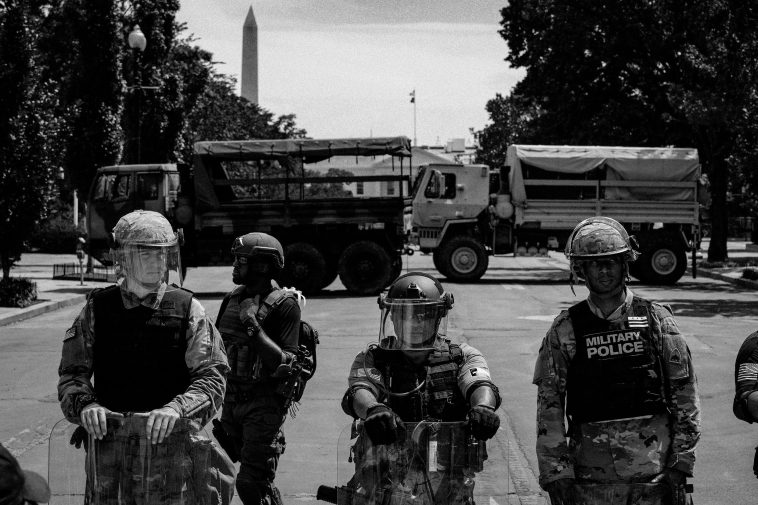It was Pearl Harbor–level language. “America’s sovereignty is under attack,” Donald Trump proclaimed on day one of his return to the White House. The president’s cause for alarm? A “National emergency at the southern border,” as the administration labeled it, referring to a frontier that, for all intents and purposes, was comparatively quiet.
The same day, he called on the commanders of the US armed forces to prepare for potential domestic law enforcement. To that end, he asked that plans be drawn up to invoke, if necessary, a nearly 220-year-old “insurrection” law that would give him authority to send federal troops to crack down on the purported southern “invasion.” Later that week, the new secretary of defense, Pete Hegseth, said in his first remarks at the Pentagon that the military was ready to shift its priorities from possible overseas deployment and engagement to “the defense of the territorial integrity of the United States of America” in compliance with “the Constitution, the laws of our land and the directives of the commander.”
And this past weekend, President Trump and Governor Greg Abbott reached a deal to grant the Texas National Guard new authority to make immigration arrests as long as they were alongside immigration officers and border patrol agents. This was, in fact, a “legal action,” but one normally seen only in times of serious crises.
Such declarations and acts seemed chilling, yet specific: Trump’s and Hegseth’s decrees clearly targeted migrants seeking to destabilize the American homeland. Then again, maybe not. Indeed, some have begun to wonder if the president and secretary of defense are preparing for a more all-encompassing contingency: not only an armed bulwark against an already diminishing immigrant influx at the border, but also for a mobilization that could be utilized against political opponents who supposedly threaten the nation’s “territorial integrity”—with troops potentially marching into states and sanctuary cities, even schools and private homes, that resist deportation orders. This is, after all, the playbook of autocrats. Reminder: shaking free of such ironclad bonds to executive and military authority is why the colonies rebelled against the British in the first place.
What might the president be up to? What are the precedents for invoking the Insurrection Act? And what are individual members of the American military doing to anticipate choices they may have to make in the weeks and months ahead?
Trump, it should be noted, flirted with invoking the Insurrection Act during his first administration. That law, which is an amalgamation of statutes enacted between 1792 and 1871, grants the president sole authority to send armed forces into rebellious states, even over the objections of their governments. During the civil unrest that followed the murder of George Floyd, on June 1, 2020, Trump warned, “If a city or state refuses to take the actions that are necessary to defend the life and property of their residents, then I will deploy the United States military and quickly solve the problem for them.” The New York Times noted at the time that Trump planned to announce he was ready to use his powers under the rarely invoked law to override governors and send active-duty troops to states where there were protests. Trump was reportedly dissuaded from such a declaration by senior White House and Pentagon officials.
But that same month, he did send troops into Washington, DC, the one place in the country where he would not face opposition from a governor. That was when peaceful demonstrators were forcefully cleared from Lafayette Square by US Park Police, National Guard members, and law enforcement officers from various federal agencies, including the Secret Service. On that occasion, Secretary of Defense Mark Esper, along with Mark Milley—the chairman of the Joint Chiefs of Staff, dressed in US Army fatigues—walked briefly together with Trump into the square, stopping at St. John’s Church, where the president posed for photographs while holding a Bible.
Shortly thereafter, a chagrined Milley issued an apology for agreeing to take part in such a display. “I should not have been there,” he stated during a commencement address at National Defense University, an educational center for top military and national security leadership in Washington, DC. “My presence in that moment and in that environment created a perception of the military involved in domestic politics. As a commissioned uniformed officer, it was a mistake that I have learned from, and I sincerely hope we all can learn from it.” Milley, now retired and recently granted a preemptive pardon by Joe Biden, still faces Trump’s wrath—including possible demotion in rank—for this and other statements and actions.
The Insurrection Act is murky. Part of the reason is that sending soldiers to do police work is inherently risky, even when seemingly justified. The last time the Insurrection Act was invoked was almost 33 years ago. In May 1992, George H.W. Bush summoned the Marines to help quell the Los Angeles riots that followed the acquittals of four officers charged with assault in the beating of Rodney King. Some 13,500 federal troops, including more than 10,000 from the California National Guard, accompanied the LAPD.
At one point, in the waning days of the unrest, seven marines went along with two local police officers responding to a domestic violence call. What was an ordinary situation for the cops was anything but for the soldiers, according to Joseph Nunn, a lawyer who works with the Liberty and National Security Program of the Brennan Center, an independent think tank. “These Marines now found themselves playing a role for which they had little training: that of civilian law enforcement officer,” he explains in a report on reforming the Insurrection Act. He describes the scene: someone inside the house fired a shotgun through the door. One of the officers shouted, “Cover me.” For the police, that meant: hold your weapons up in a position ready to fire, if necessary. “The Marines,” writes Nunn, “in accordance with their own training, took it as a request for suppressing fire. They riddled the home with more than 200 bullets. Miraculously, no one was killed.”
This is not to say that trained US soldiers are never deployed on American soil. Today, under normal legal precedent, the military is already actively working in support of law enforcement, with some 4,000 federal troops aiding border and Customs agents, though typically without power to arrest offenders. The Pentagon, meanwhile, operates military flights when apprehended immigrants are returned to their home nations. But these activities are different from direct, face-to-face engagement by uniformed military personnel in domestic law enforcement matters. To take that fateful step, Trump would have to invoke the Insurrection Act.
The first step down this path came on Inauguration Day. Trump’s emergency order set a 90-day deadline for the secretaries of defense and homeland security to have an action plan for obtaining “complete operational control of the southern border, including whether to invoke the Insurrection Act.”
Why would the president need such approval? Because of Congress’s checks and balances on a president’s executive power when it comes to using troops. The Constitution, in various ways, limits military involvement in civilian affairs. But it does not entirely bar federal armed forces from conducting law enforcement actions. Instead, a partial prohibition comes from the Posse Comitatus Act of 1878. In it, Congress expressly forbids federal armed forces from acting as police on the nation’s streets unless such action is authorized by Congress or the Constitution. But there’s one gaping loophole that comes into play only when the president, in a time of national or state emergency, unilaterally invokes the Insurrection Act. According to the Brennan Center: “The Insurrection Act allows the president—with or without the state government’s consent—to use the military to enforce federal law or suppress a rebellion against federal authority in a state.” Even if a state’s government objects, soldiers can, at the president’s behest, march in to stop insurrections and act as police.
In its more than two centuries as a law, the Insurrection Act has been invoked 30 times. Earlier instances include Abraham Lincoln sending Union forces against the rebellious states in the Civil War; presidents dispatching soldiers multiple times to break worker strikes during labor disputes; and Eisenhower, Kennedy, and Johnson deploying troops to end resistance to desegregation orders in the American South. As Nunn tells me, “History makes clear the Insurrection Act is a tool of last resort, not something to be used for routine law enforcement or longstanding policy challenges,” such as unlawful immigration. “Immigration enforcement,” he insists, “is law enforcement.”
Even so, the loose language of the Insurrection Act leaves the ultimate determination to the president. He alone can decide when a crisis amounts to a rebellion against federal authority. That potentially opens the door to sending troops uninvited into states and cities experiencing civil unrest or, perhaps, even for harboring undocumented immigrants and actively obstructing federal law enforcement. From Nunn’s perspective, the Insurrection Act “grants a dangerous amount of discretion to the president that is, in a very real sense, incompatible with what it means to be a free society ruled by law.”
In any case, Trump is not necessarily prone to follow constitutional niceties. And given the courts’ deference to executive authority in recent rulings, Nunn fears that “a legal challenge to invocation of the Insurrection Act would be difficult.”
What, then, might military officers and soldiers do if ordered to enter cities and towns—not merely to support but to act in concert with ICE agents and local police in enforcing crackdowns on citizens or officials intent on obstructing attempts to identify, detain, and deport immigrants?
I reached out to more than a dozen current and former military officers through various channels. Only a few would speak with me, and only anonymously. One recently retired higher-up, who worked in the Navy’s most-decorated echelons, disclosed that many people at the top ranks are “on edge about what’s coming next” and at the prospect of facing “unconstitutional orders.” He says, “They are very intent and focused on what their oath was about: to support and defend the Constitution…. On not crossing that line into police action and civil actions. If you use that [Insurrection] Act to walk into a city to arrest civilians or immigrants, boy, that’s a big, big step that will be very difficult for a lot of officers to do.”
He is careful to point out that he is “not saying there’s going to be an insurrection,” but he thinks it will roil the services badly. “There are some people who would resign,” he insists. “But if those with a moral compass resign, who’s going to replace them?” He fears people may move into positions of authority whose loyalty is to the president and not their oath to the Constitution. If that happens, he notes, “That’s the end of democracy.”
Another former senior Navy officer and veteran of combat tours in Iraq and Afghanistan is still affiliated with the Pentagon. “Fear,” he tells me, “is currently the prevailing sentiment within the organizational culture.” The anxiety arises, the retired officer contends, because “nobody knows what’s coming next. In the military, we don’t like not knowing what’s coming next. Now it’s from within.” He laments, “It’s not cool to use military personnel to put people in internment camps. I didn’t go to war to see this kind of thing happen in our country.” He now worries about speaking to others in the service. “There are true believers and you gotta be careful. You just don’t know who you’re talking to”—or which of one’s confidants might be inclined to pass along a comment to their superiors.
Carrying out what some might regard as an unlawful order, even under the auspices of the Insurrection Act, could potentially subject officers and soldiers to legal jeopardy. Eugene R. Fidell teaches military justice at Yale Law School. He cofounded the Orders Project after the deployment of federal armed forces to the capital in 2020. The organization, currently affiliated with the National Institute of Military Justice, was created to be a resource for present and former military personnel and senior officers who may need to speak with counsel because of their unwillingness to carry out orders they consider unlawful—or because of concerns about retribution from the Pentagon or the administration.
“We need to be ready,” Fidell says. Since Trump’s return to office, “Obviously there are concerns everywhere in civil society about military personnel called upon to carry out orders whose lawfulness is questionable…. The administration has made no bones about its plans to cull the senior officer corps of officers whose loyalty to President Trump and his policies might be open to question.” He ticks off various actions the commander-in-chief has already taken to shake out resistance within the Department of Defense, including the dismissal of the Commandant of the Coast Guard; the dismantling of diversity, equity, and inclusion programs, along with ordering the firing of administrators of such initiatives; as well as saber-rattling against allies such as Denmark and Panama. Not to mention the frequent attacks on General Milley. “There is an overall pattern that would scare anybody who cares about national defense.”
Military personnel are subject to the Uniform Code of Military Justice, a federal law that criminalizes and sets punishments—up to the death penalty—for the disobedience of lawful orders. But the Constitution also makes it clear that sending tanks and troops into American cities, even on the president’s orders, may only be legal in certain situations. Determining whether an order is unlawful might prove difficult for soldiers sent to police their fellow citizens. “Military personnel should be scrupulous in obeying lawful orders. You do not get to pick and choose,” Fidell explains. “You can’t disobey because you disagree with the policy.” There is only one rationale for disobedience, he says: “The orders have got to be unlawful.”
He lays out a possible example of the ambiguities military personnel could encounter: “Suppose the Insurrection Act is lawfully invoked,” he says, “and then the orders are ‘shoot to kill.’ There’s both a macro and a micro dimension of lawfulness. It’s possible the administration’s directives might touch one third rail but not the other.” Fidell thinks that the military justice system might be forced to face what he calls “stress tests” by personnel refusing to carry out orders they consider unlawful. An order’s lawfulness could end up being decided by either military or federal courts. In either case, Fidell has his doubts about whether Trump or his designees will obey a ruling, should it go against the administration. “Experience teaches that Trump will not give a damn [what the courts decide],” he says, “and, quite the reverse, will see it as an opportunity for further performative decision-making.” That, he claims, might leave only military officials to resist unlawful orders.
Like many retired members of the armed forces, one former senior officer tells me that it is not out of the realm of possibility that he might get called back to active duty. The combat veteran admits, “If I’m asked to do something unlawful, I don’t know what I would do. But I swore an oath to the Constitution. That’s it. That’s the bottom line.”
And on Inauguration Day, so, too, did Donald Trump.
Inside Prince Harry and Meghan Markle’s Big Business Ambitions, 5 Years After Their Royal Exit





GIPHY App Key not set. Please check settings